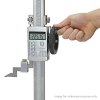phileakins
Western Thunderer
This arrived, courtesy of Parcelforce, this morning.
Checking on the name on the inside of the lid of the box this gauge must have been manufactured before 1951 when the company changed its name and its business model.
It's been well used, the column has been polished so often the graduations are now very faint. I would like to restore it but have a couple of questions. There is space for a couple of rods, about 1/4" and 1/8" and perhaps a foot or so long. A search has found this advertisement (from the 1940s by the look of it) which shows one of the rods with a knurled end and something hanging off it.
Can any of you knowledgeable Westerners tell me what I am looking at, please? Any further information would also be gratefully received.
Ta ever so.
Phil

Checking on the name on the inside of the lid of the box this gauge must have been manufactured before 1951 when the company changed its name and its business model.
It's been well used, the column has been polished so often the graduations are now very faint. I would like to restore it but have a couple of questions. There is space for a couple of rods, about 1/4" and 1/8" and perhaps a foot or so long. A search has found this advertisement (from the 1940s by the look of it) which shows one of the rods with a knurled end and something hanging off it.
Can any of you knowledgeable Westerners tell me what I am looking at, please? Any further information would also be gratefully received.
Ta ever so.
Phil


 There needs to be more length in the section directly behind the scriber edge.
There needs to be more length in the section directly behind the scriber edge.
![100_0742[1].JPG 100_0742[1].JPG](https://www.westernthunder.co.uk/data/attachments/106/106688-6897af561c57287d941d880568b42281.jpg)

